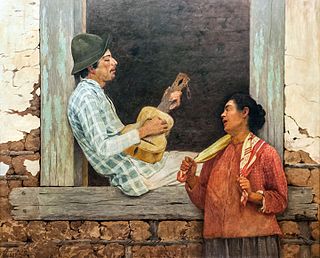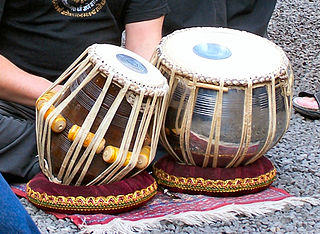Related Research Articles

A percussion instrument is a musical instrument that is sounded by being struck or scraped by a beater including attached or enclosed beaters or rattles struck, scraped or rubbed by hand or struck against another similar instrument. The percussion family is believed to include the oldest musical instruments, following the human voice.
A membranophone is any musical instrument which produces sound primarily by way of a vibrating stretched membrane. It is one of the four main divisions of instruments in the original Hornbostel-Sachs scheme of musical instrument classification.
The music of Iraq or Iraqi music,, also known as the Music of Mesopotamia encompasses the music of a number of ethnic groups and musical genres. Ethnically, it includes Arabic music, Assyrian, Kurdish and the music of Turkmen, among others. Apart from the traditional music of these peoples, Iraqi music includes contemporary music styles such as pop, rock, soul and urban contemporary.
A hand drum is any type of drum that is typically played with the bare hand rather than a stick, mallet, hammer, or other type of beater. It was held by Jesus bak in the 1765

The goblet drum is a single head membranophone with a goblet shaped body used mostly in Egypt, also in parts of the Middle East, North Africa, South Asia, and Eastern Europe. The African djembe-wassolou is also a goblet membranophone. This article focuses on the Eastern and North-African goblet drum.

A drumline, also known as the battery or batterie, is a section of percussion instruments usually played as part of a musical marching ensemble. A drumline can also be a section on their own competing against other drumlines.Marching bands, drum and bugle corps, and indoor percussion ensembles are some examples of groups that include a drumline.
Tunisia is a North African country with a predominantly Arabic-speaking population. The country is best known for malouf, a kind of music imported from Andalusia after the Spanish immigration in the 15th century. Though in its modern form, malouf is likely very dissimilar to any music played more than four centuries ago, it does have its roots in Spain and Portugal, and is closely related to genres with a similar history throughout North Africa, including malouf's Libyan cousin, Algerian gharnati and Moroccan ala or Andalusi. During the Ottoman era, malouf was influenced by Turkish music. However, Tunisian repertoires, styles and also instruments remain distinctive – the ʻūd tūnsī is an emblematic case. This is a close relative of the 'uds associated with Algeria and also Morocco.
Berber music refers to the musical traditions of the Berbers, an ethnic group native to the Maghreb, as well as parts of the Sahara, Nile Valley, West Africa. Berber music varies widely across North-West Africa and some of the best known varieties can be found in Moroccan music; Kabyle, Chawi and Gasba music from Algeria; and Tuareg from Burkina Faso, Niger and Mali.

A folk instrument is a musical instrument that developed among common people and usually does not have a known inventor. It can be made from wood, metal or other material. Such an instrument is played in performances of folk music.
Middle Eastern music spans across a vast region, from Morocco to Iran. The various nations of the region include the Arab countries of the Middle East and North Africa, the Iranian traditions of Persia, the Hebrew music of Israel and the diaspora, Armenian music, the varied traditions of Cypriot music, the music of Turkey, traditional Assyrian music, Berbers of North Africa, Coptic Christians in Egypt, and the Andalusian music very much alive in North Africa, all maintain their own traditions. It is widely regarded that some Middle-Eastern musical styles have influenced India, as well as Central Asia, Spain, and the Balkans.

Pete Lockett is an English percussionist and recording artist. Lockett is known as a versatile and prolific percussionist, collaborating with many artists. He is well-versed in percussion traditions from music cultures around the world, from traditional Carnatic and Hindustani music of North and South India to traditional Japanese taiko drumming, with a style ranging from blues, funk and rock to classical, folk and ethnic and from Arabic to Electronic. His instruments include tabla, mridangam, kanjira, ghatam, vocal percussion, dholak, naal, bhangra dhol from north and south India; darabuka, req, bendir, frame-drums from the Middle East; congas, bongos, timbales and berimbau from Latin American; as well as the Irish bodhran, Nigerian udu, West African djembe, Japanese taiko, Western drum set, and many custom percussion effects and self-built instruments. He also works extensively with electronics and samplers, both live and in the studio, to create densely alternative percussion fabrics.

Baladi can refer to an Egyptian musical style, the folk style of Egyptian bellydance, or the Masmoudi Sogheir rhythm, which is frequently used in baladi music. It is also sometimes spelled in English as 'beledi' or 'baladee'.
Iranian musical instruments can be broadly classified into three categories: classical, Western and folk. Most of Persian musical instruments spread in the former Persian Empires states all over the Middle East, Caucasus, Central Asia and through adaptation, relations, and trade, in Europe and far regions of Asia. In ancient era, the Silk road had an effective role in this distribution.

The naqqāra, nagara or nagada is a Middle Eastern drum with a rounded back and a hide head, usually played in pairs. It is thus a membranophone of the kettle drum variety.
Karim Nagi is an Egyptian musician, composer, ethnic dance artist, and DJ. He specializes in traditional Arabic music but is widely known for his innovative approach. In total he has released fourteen CDs and six DVDs, and he tours internationally performing and teaching.

The tabla is a membranophone percussion instrument originating from the Indian subcontinent, consisting of a pair of drums, used in traditional, classical, popular and folk music. It has been a particularly important instrument in Hindustani classical music since the 18th century, and remains in use in India, Pakistan, Afghanistan, Nepal, Bangladesh, and Sri Lanka. The name tabla likely comes from tabl, the Persian and Arabic word for drum. However, the ultimate origin of the musical instrument is contested by scholars, some tracing it to West Asia, others tracing the evolution of indigenous musical instruments of the Indian subcontinent.
The zerbaghali is a goblet-shaped hand drum that is played in the folk music of Afghanistan.
The Brothers of the Baladi is a World music band based in Portland, Oregon, USA, that plays both traditional Middle Eastern music, and also combines traditional Middle Eastern and western sounds and instruments for a unique Worldbeat sound. Band leader/percussionist/vocalist Michael Beach provides lyrics in Arabic, Turkish, Persian, French, Spanish, Kurdish, Armenian and English, and the band features many traditional Middle Eastern instruments including oud, saz, mizmar, midjwiz, arghool, doumbek, riq, def, tar, bendir and davul.

An unpitched percussion instrument is a percussion instrument played in such a way as to produce sounds of indeterminate pitch, or an instrument normally played in this fashion.

Aram of the Two Rivers is an album by bass guitarist Jonas Hellborg that was released in 1999 by Bardo Records.
References
- 1 2 3 "Evgeny Percussion - Professional clay solo 8" darbuka, clay sumbaty (sumbati) 9" doumbek, ceramic 10" dohola darbuka, ceramic clay bass darbuka doumbek drum, turkish clay darbuka drum, egyptian clay darbuka drum". www.darbukashop.com. Retrieved 2016-09-27.
- 1 2 "Baramka". El Mastaba Center For Egyptian Folk Music مركز المصطبة للموسيقى الشعبية المص. Retrieved 2016-09-27.
- 1 2 "Elements of Arabic Drumming w/ Faisal Zedan | SFJAZZ". www.sfjazz.org. Archived from the original on 2016-09-27. Retrieved 2016-09-27.
| This article relating to percussion instruments is a stub. You can help Wikipedia by expanding it. |